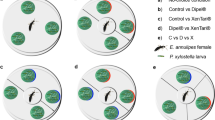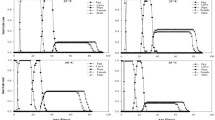Abstract
Laboratory experiments were conducted to determine the effects of M-One™ (Bacillus thuringiensis var.san diego) on larval instars ofColeomegilla maculata lengi Timberlake. Coccinellid larval development (from egg hatch to adult), completed on pollen treated with suspensions of M-One™ at 20 ml/litre (5.6×108 CPBIU/litre) and 200 ml/litre, took respectively 29.3 and 38.5 days compared with 21.9 days for the control (water). M-One™ did not cause larval mortality.C. maculata third instars did not show any preference between eggs ofLeptinotarsa decemlineata (Say) treated with water or with M-One™ at 20 ml/litre. However, at 200 ml M-One™/litre, the number of eggs attacked was 34.7% lower than the eggs treated with water only, 48 h after the beginning of the test. These results indicate that the use of M-One™, at the manufacturer's recommended field rate of 20 ml/litre, does not cause a major threat to larvalC. maculata populations.
Résumé
Des bioessais en laboratoire ont été effectués afin de déterminer si les larves de la coccinelle maculée,Coleomegilla maculata lengi Timberlake (Col.: Coccinellidae), sont affectées par M-One™, un insecticide biologique préparé à partir de la bactérieBacillus thuringiensis var.san diego Berliner et utilisé dans la lutte contre le doryphore de la pomme de terre,Leptinotarsa decemlineata (Say) (Col.: Chrysomelidae). Le développement larvaire, effectué sur du pollen traité avec des concentrations de 20 ml M-One™/litre (5,6×108 unités internationales de doryphore/litre) et 200 ml M-One™/litre, a nécessité 29,3 et 38,5 jours respectivement, comparativement à 21,9 jours pour le témoin (eau). M-One™ n'a pas causé de mortalité chez les larves. Au cours d'un test de 48 h, les larves de stade III n'ont montré aucune préférence entre des œufs traités avec 20 ml M-One™/litre et des œufs traités avec de l'eau. Par contre avec 200 ml M-One™/litre, le nombre d'œufs attaqués a diminué significativement de 34,7% par rapport au témoin, 48 h après le début du test. Ces résultats indiquent que l'utilisation de M-One™ à la concentration recommandée de 20 ml/litre ne représente pas une menace pour les populations larvaires de la coccinelle maculée.
Similar content being viewed by others
References
Abacus Concepts Inc.—1988. Statview user's guide. Brain Power Inc., Calabasas, CA.
Abacus Concepts Inc.—1989. SuperANOVA user's guide. BrainPower Inc., Calabasas, CA.
Adang, M.—1991.Bacillus thuringiensis insecticidal crystal proteins: gene structure, action and utilization.—In:Biotechnology for biological control of pests and vectors, (Maramorosh, K., (ed.))—CRC Press, Boca Raton, Floride, 3–24.
Andrews, R. E. Jr., Faust, R. M., Wabiko, H. &Raymond, K. C.—1987. The biotechnology ofBacillus thuringiensis.—CRC Critical Reviews in Biotechnology, 6, 163–232.
Brown, A. W. A.—1971. Pest resistance to pesticides.—In: Pesticides in the environment, vol. I (part II), (R. White-Stevens (ed.))—Marcel Dekker, Washington, D.C., 457–552.
Chagnon, M., Payette, A., Jean, C. &Cadieux, C.—1990. Modes alternatifs de répression des insectes dans les agro-écosystèmes québécois, tome 2: Identification des insectes ravageurs et état de l'agriculture biologique au Québec.Ministère de l'Environnement et Centre québécois de valorisation de la biomasse. Québec, 85 p.
Cidaria, D., Cappai, A., Vallesi, A., Caprioli, V. &Pirali, G.—1991. A novel strain ofBacillus thuringiensis (NCIMB 40152) active against coleopteran insects.FEMS Microbiol. Lett., 81, 129–134.
Coderre, D., Provencher, L. &Tourneur, J.-C.—1987. Oviposition and niche partitioning in aphidophagous insects on maize.—Can. Entomol., 119, 195–203.
Donovan, W.P., Gonzalez, J. M. Jr., Pearce Gilbert, M. &Dankocik, C.—1988. Isolation and characterization of EG 2158, a new strain ofBacillus thuringiensis toxic to coleopteran larvae, and nucleotide sequence of the toxic gene.Mol. Gen. Genet., 214, 365–372.
Forgash, A. J.—1985. Insecticide resistance in the Colorado potato beetle.—In: Proceedings of the symposium on the Colorado potato beetle, XVIIth International Congress of Entomology, (Ferro, D. N. & Voss, R. H. (eds.)), Massachusetts Agricultural Experiment Station Research Bulletin 704, Amherst, Mass. USA, 33–53.
Gill, S. S., Cowles, E. A. &Pietrantonio, P. V.—1992. The mode of action ofBacillus thuringiensis endotoxins.—Ann. Rev. Entomol., 37, 615–636.
Giroux, S., Côté, J.-C., Vincent, C., Martel, P. &Coderre, D.—1994. Bacteriological insecticide M-One™ effects on predation efficiency and mortality of adultColeomegilla maculata lengi (Coleoptera: Coccinellidae).J. Econ. Entomol., 87, 39–43.
Groden, E., Drummond, F. A., Casagrande, R. A. &Haynes, D. L.—1990.Coleomegilla maculata (Coleoptera: Coccinellidae): its predation upon the Colorado potato beetle (Coleoptera: Chrysomelidae) and its incidence in potatoes and surroundings crops.—J. Econ. Entomol., 83, 1306–1315.
Hazzard, R. V. &Ferro, D. N.—1991. Feeding responses of adultColeomegilla maculata (Coleoptera: Coccinellidae) to eggs of Colorado potato beetle (Coleoptera: Chrysomelidae) and green peach aphids (Homoptera: Aphididae).—Environ. Entomol., 20, 644–651.
Hazzard, R. V., Van Driesche, R. G. &Tuttle, A. F.—1991. Mortality of eggs of Colorado potato beetle (Coleoptera: Chrysomelidae) from predation byColeomegilla maculata (Coleoptera: Coccinellidae). —Environ. Entomol., 20, 841–848.
Herrnstadt, C., Soares, G., Wilcox, E. &Edwards, D.—1986. A new strain ofBacillus thuringiensis against coleopteran insects.—Biotechnology, 4, 305–308.
Herrnstadt, C., Gaertner F., Gelernter, W. &Edwards, D. L.—1987.Bacillus thuringiensis isolate with activity against Coleoptera.In: Biotechnology in Invertebrates, Pathology and Cell Culture, (K. Maramorosch (ed.)).—Academic Press, San Diego, 101–114.
Hodek, I., Ruzika, Z. &Hodkova, M.—1978. Feeding on pollen and aphids byColeomegilla maculata lengi.—Ann. Zool. Ecol. Anim., 10, 453–459.
Hodek, I.—1973. Biology of Coccinellidae.Academia, Prague.
Hudon, M.—1986. Biology and population dynamics of the European corn borer (Ostrinia nubilalis) with special reference to sweet corn in Québec. III. Population dynamics and spatial distribution.—Phytoprotection, 67, 93–115.
Krieg, H., Huger, A. &Schnetter, W., Langenbruch, G. A. &Schnetter, W.—1983.Bacillus thuringiensis var.tenebrionis, a new pathotype effective against larvae of Coleoptera.—Z. angew. Entomol., 96, 500–508.
Krieg, V.A., Huger, A., Langenbruch, G. &Schnetter, W.—1984. New results onBacillus thuringiensis var.tenebrionis with special regard to its effects on the Colorado potato beetle (Leptinotarsa decemlineata).—Anz. Schädlingskde., Pflanzenschutz, Umweltschutz. 57, 145–150.
Lakocy, A.—1976. Studies on the development of acquired and cross resistance of hibernating adults of the Colorado potato beetle (Leptinotarsa decemlineata Say) to insecticides in the Voivodships of Posnan, Warsaw and Wroclow during the years 1972–1975.—Prace Naukowe Instytutu Ochrony Roslin., 17, 97–141.
Martel, P.—1987. Chemical control and resistance development in potato pests.In: Potato pest management in Canada.—Lutte contre les parasites de la pomme de terre au Canada, (G. Boiteau, Singh, R. &Parry, R. (eds.)). Frédéricton, Nouveau-Brunswick, 173–183.
Mateeva, A., Kuzmanova, I., Sapundjiva, S. & Loginova, E.—1991. The effects of some bacterial preparations on the density and structure ofCoccinella septempunctata L. population in potato fields.In: First National Conference of Entomology, 28–30 October, Sofia, Bulgaria, 109–113.
Warren, L. O. &Tadic, M.—1967. Biological observations onColeomegilla maculata and its role as a predator of the Fall webworm.—J. Econ. Entomol., 60, 1492–1496.
Zehnder, G. W. &Gelernter, W. D.—1989. Activity of the M-One formulation of a new strain ofBacillus thuringiensis against the Colorado potato beetle (Coleoptera: Chrysomelidae): relationship between susceptibility and insect life stage.—J. Econ. Entomol., 82, 756–761.
Author information
Authors and Affiliations
Rights and permissions
About this article
Cite this article
Giroux, S., Coderre, D., Vincent, C. et al. Effects ofBacillus thuringiensis var.San diego on predation effectiveness, development and mortality ofColeomegilla maculata lengi (Col.: Coccinellidae) larvae. Entomophaga 39, 61–69 (1994). https://doi.org/10.1007/BF02373495
Received:
Accepted:
Issue Date:
DOI: https://doi.org/10.1007/BF02373495




